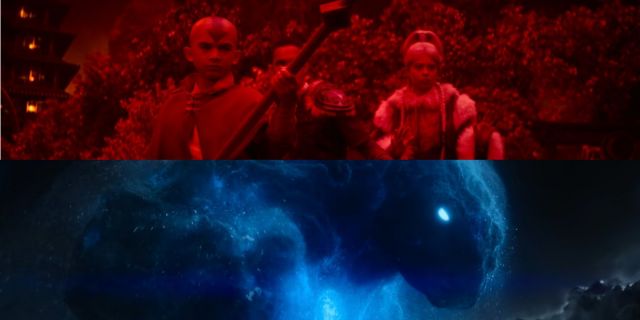Quick Links
- How Does Netflix’s Avatar: The Last Airbender End?
- What Is Netflix’s Avatar: The Last Airbender About?
- What Do The Critics Think About Netflix’s Avatar: The Last Airbender?
The long-awaited Avatar: The Last Airbender on Netflix is a live-action retelling of the hit animated series which aired on Nickelodeon from 2005 to 2008. As favorite moments and beloved characters come to life, this version of the fantasy-adventure show has sparked the imaginations of old and new fans alike.
The first season of the Netflix series covers “Book One: Water” from the animated show, as characters Aang, Katara, Sokka, and more are introduced. Like the original, the ending of Season 1 has Aang and his friends helping the Northern Water Tribe fight off an attack by the Fire Nation’s armada, led by the ambitious military leader, Zhao. Although Team Avatar proved to be victorious, the ending of Avatar: The Last Airbender Season 1 reveals more perils still to come. Here’s the ending of Netflix’s Avatar explained.
How Does Netflix’s Avatar: The Last Airbender End?
Things are dire for Team Avatar and the Northern Water Tribe in the final episode, “Legends.” While the Fire Nation’s ships attack from the front, Admiral Zhao carries out a secret plan to destroy the Moon and Ocean spirits once and for all. After Zhao captures and kills the Moon spirit, Aang takes drastic measures by going into the Avatar state and allowing the Ocean spirit to possess him. After Princess Yue makes the ultimate sacrifice, it takes a heartfelt plea from Katara to ease Aang out of his destructive form.
Meanwhile, things in the city of Omashu have come to a head, as the Fire Nation takes over the city and King Bumi is captured. The leader of the siege is none other than Azula, Zuko’s scheming sister and daughter of Fire Lord Ozai. Tired of being the victim of her father’s constant tests, Azula finally gets her moment to prove herself, and she shows no signs of stopping.
In the aftermath of the battle, Aang takes time to contemplate his situation. He carries a heavy burden – not only his status as the Avatar, but the guilt for his 100-year disappearance. Everywhere he goes, he sees chaos and destruction, and he feels responsible. But with Katara’s words, and the memory of Gyatso’s teachings, Aang finally comes to realize that dwelling in the past will only hold him back from a brighter future. And with the threat from the Fire Nation still bearing down upon them, Aang is the only hope the future has.
What Is Netflix’s Avatar: The Last Airbender About?
Avatar: The Last Airbender takes place in a fantasy world where the elements of earth, air, fire, and water are manipulated by people called benders, who can “bend” the elements to their will. For centuries, there has been one known as the Avatar, a single person each generation who can use all four elements and bring balance to the world. When a new Avatar is born, they take on the essences of all the other Avatars before them.
A young boy named Aang, an airbender, resides in the Northern Air Temple with airbender monks, as well as his mentor and friend, Gyatso. Beyond the walls of the temple, the world is on the brink of a war with the Fire Nation. When Gyatso reveals to Aang that he is the Avatar, Aang becomes frightened and flies away on his sky bison, Appa. As they soar over the sea, a raging storm threatens their safety, and Aang involuntarily goes into the Avatar state – a powerful form which Aang cannot control – and he and Appa are encased in a ball of ice for 100 years.
When Aang awakens from his long sleep, he meets Katara and Sokka, siblings from the Southern Water Tribe. Aang learns that the world is under threat from the Fire Nation in Fire Lord Ozai’s attempt to conquer them all. Reluctantly, Aang accepts that he must begin his training as the Avatar in order to stop the Fire Nation from taking over. He is joined by Sokka and Katara, who wish to aid him in his quest.
Meanwhile, the son of Ozai, Prince Zuko, searches for the Avatar in an attempt to get back into his father’s good graces. He is joined by his uncle, a good-natured man named Iroh. As Aang and his companions travel the world making new friends and escaping various dangers, they learn to grow from adolescence into maturity.
What Do The Critics Think About Netflix’s Avatar: The Last Airbender?
The Netflix live-action adaptation of Avatar: The Last Airbender received mostly positive reviews from critics. Many reviewers have described the series as falling short of the charm of the original animated show, but also pointed out that it is, at least, far superior to the panned 2010 M. Night Shyamalan film.
“The new show is nowhere near the failure of the film, nor as spectacular as the series — but it’s not of uniform quality, either,” writes Mashable.
Rolling Stone praised the performances of the show’s actors while calling out the sub-par CGI effects, and all-in-all seemed to enjoy the changes from the original. “As these things go, this new Last Airbender is entertaining enough to work for newcomers to this world, and respectful enough to remind the cartoon’s fans why they loved that world in the first place,” critic Alan Sepinwall states.
Avatar: The Last Airbender currently holds a 60% critic approval rating on Rotten Tomatoes, and Metacritic gives it a score of 56. However, it seems that general audiences are a bit more forgiving of the show’s flaws. The Rotten Tomatoes audience score is 75%, and Metacritic’s user score is 6.5.











Leave a Reply